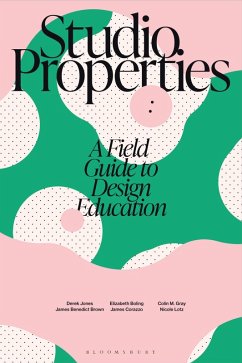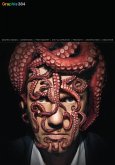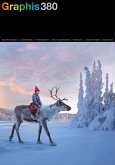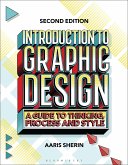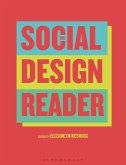Derek Jones (UK Open University), Elizabeth Boling (USA Indiana University), James Benedict Brown (Sweden Umea University)A Field Guide to Design Education
Studio Properties
A Field Guide to Design Education
Herausgeber: Sherin, Aaris
Derek Jones (UK Open University), Elizabeth Boling (USA Indiana University), James Benedict Brown (Sweden Umea University)A Field Guide to Design Education
Studio Properties
A Field Guide to Design Education
Herausgeber: Sherin, Aaris
- Broschiertes Buch
- Merkliste
- Auf die Merkliste
- Bewerten Bewerten
- Teilen
- Produkt teilen
- Produkterinnerung
- Produkterinnerung
A guide and reference text in studio education for design educators and researchers in higher education.
Andere Kunden interessierten sich auch für
![Beginner's Guide to Digital Painting in Clip Studio Paint Beginner's Guide to Digital Painting in Clip Studio Paint]() Beginner's Guide to Digital Painting in Clip Studio Paint24,99 €
Beginner's Guide to Digital Painting in Clip Studio Paint24,99 €![Graphis Journal Magazine 384 Graphis Journal Magazine 384]() B. Martin PedersenGraphis Journal Magazine 38422,99 €
B. Martin PedersenGraphis Journal Magazine 38422,99 €![Graphis Journal Magazine 380 Graphis Journal Magazine 380]() B. Martin PedersenGraphis Journal Magazine 38026,99 €
B. Martin PedersenGraphis Journal Magazine 38026,99 €![Composition Composition]() Arthur Wesley DowComposition43,99 €
Arthur Wesley DowComposition43,99 €![Introduction to Graphic Design Introduction to Graphic Design]() Aaris Sherin (St John's University, New York, USA)Introduction to Graphic Design57,99 €
Aaris Sherin (St John's University, New York, USA)Introduction to Graphic Design57,99 €![Design Thinking Design Thinking]() Prof. Nigel CrossDesign Thinking18,99 €
Prof. Nigel CrossDesign Thinking18,99 €![The Social Design Reader The Social Design Reader]() Elizabeth ResnickThe Social Design Reader42,99 €
Elizabeth ResnickThe Social Design Reader42,99 €-
-
-
A guide and reference text in studio education for design educators and researchers in higher education.
Produktdetails
- Produktdetails
- Design Teaching
- Verlag: Bloomsbury Publishing PLC
- Seitenzahl: 344
- Erscheinungstermin: 21. August 2025
- Englisch
- Abmessung: 234mm x 157mm x 25mm
- Gewicht: 586g
- ISBN-13: 9781350407503
- ISBN-10: 135040750X
- Artikelnr.: 71162110
- Herstellerkennzeichnung
- Libri GmbH
- Europaallee 1
- 36244 Bad Hersfeld
- gpsr@libri.de
- Design Teaching
- Verlag: Bloomsbury Publishing PLC
- Seitenzahl: 344
- Erscheinungstermin: 21. August 2025
- Englisch
- Abmessung: 234mm x 157mm x 25mm
- Gewicht: 586g
- ISBN-13: 9781350407503
- ISBN-10: 135040750X
- Artikelnr.: 71162110
- Herstellerkennzeichnung
- Libri GmbH
- Europaallee 1
- 36244 Bad Hersfeld
- gpsr@libri.de
Derek Jones, Colin Gray, James Brown, James Corazzo, Nicole Lotz, Elizabeth Boling
Introduction
Part 1 The Properties
Visibilities and Proximities
1. Making Visible
2. Extended and Distributed Cognition
3. Informal Learning Spaces
4. No Front
5. Surfaces
6. Cost
7. Public and Private Spaces
Foundations and Methods
8. Apprenticeship
9. Design Brief
10. Active Teaching
11. Feedback
12. Critique and the Crit
13. Reflection
Expertise and Identity
14. Expertise
15. Identities
16. Judgement
17. Character
18. Journey
19. Performance
20. Transformative Pedagogy
Time and Structures
21. Immersion
22. Time
23. Rhythms
24. Synchronicity and Proximity
25. Project Cycles
Artefacts and Making
26. Materiality
27. Learning by Doing
28. Making
29. Artefacts
30. Play
31. Prototyping
Interactions and Sociality
32. Learning and Designing Collectively
33. Listening-in
34. Social Comparison
35. Confidence to Speak
36. Dialogue
37. Social Networks
38. Belonging
Atmospheres and Place
39. Place
40. Affect
41. Informalities
42. Uncertainty and Ambiguity
43. Serendipity
44. Wellbeing
Theories and Knowledge
45. Creativity
46. Risk and Failure
47. Simulation
48. Assessment
49. Discipline
50. General Education
51. Concepts and Theories
52. Knowledge and Knowing
Culture(s) and Power
53. Habits and Rituals
54. Habitus
55. Hidden Curriculum
56. Critical Pedagogy
57. Power Transaction
58. Enculturation, Acculturation, and Indoctrination
Part 2 Narratives
1. Albert and Laura plan to team teach in studio
2. Zoe teaches a hybrid studio
References
Index
Part 1 The Properties
Visibilities and Proximities
1. Making Visible
2. Extended and Distributed Cognition
3. Informal Learning Spaces
4. No Front
5. Surfaces
6. Cost
7. Public and Private Spaces
Foundations and Methods
8. Apprenticeship
9. Design Brief
10. Active Teaching
11. Feedback
12. Critique and the Crit
13. Reflection
Expertise and Identity
14. Expertise
15. Identities
16. Judgement
17. Character
18. Journey
19. Performance
20. Transformative Pedagogy
Time and Structures
21. Immersion
22. Time
23. Rhythms
24. Synchronicity and Proximity
25. Project Cycles
Artefacts and Making
26. Materiality
27. Learning by Doing
28. Making
29. Artefacts
30. Play
31. Prototyping
Interactions and Sociality
32. Learning and Designing Collectively
33. Listening-in
34. Social Comparison
35. Confidence to Speak
36. Dialogue
37. Social Networks
38. Belonging
Atmospheres and Place
39. Place
40. Affect
41. Informalities
42. Uncertainty and Ambiguity
43. Serendipity
44. Wellbeing
Theories and Knowledge
45. Creativity
46. Risk and Failure
47. Simulation
48. Assessment
49. Discipline
50. General Education
51. Concepts and Theories
52. Knowledge and Knowing
Culture(s) and Power
53. Habits and Rituals
54. Habitus
55. Hidden Curriculum
56. Critical Pedagogy
57. Power Transaction
58. Enculturation, Acculturation, and Indoctrination
Part 2 Narratives
1. Albert and Laura plan to team teach in studio
2. Zoe teaches a hybrid studio
References
Index
Introduction
Part 1 The Properties
Visibilities and Proximities
1. Making Visible
2. Extended and Distributed Cognition
3. Informal Learning Spaces
4. No Front
5. Surfaces
6. Cost
7. Public and Private Spaces
Foundations and Methods
8. Apprenticeship
9. Design Brief
10. Active Teaching
11. Feedback
12. Critique and the Crit
13. Reflection
Expertise and Identity
14. Expertise
15. Identities
16. Judgement
17. Character
18. Journey
19. Performance
20. Transformative Pedagogy
Time and Structures
21. Immersion
22. Time
23. Rhythms
24. Synchronicity and Proximity
25. Project Cycles
Artefacts and Making
26. Materiality
27. Learning by Doing
28. Making
29. Artefacts
30. Play
31. Prototyping
Interactions and Sociality
32. Learning and Designing Collectively
33. Listening-in
34. Social Comparison
35. Confidence to Speak
36. Dialogue
37. Social Networks
38. Belonging
Atmospheres and Place
39. Place
40. Affect
41. Informalities
42. Uncertainty and Ambiguity
43. Serendipity
44. Wellbeing
Theories and Knowledge
45. Creativity
46. Risk and Failure
47. Simulation
48. Assessment
49. Discipline
50. General Education
51. Concepts and Theories
52. Knowledge and Knowing
Culture(s) and Power
53. Habits and Rituals
54. Habitus
55. Hidden Curriculum
56. Critical Pedagogy
57. Power Transaction
58. Enculturation, Acculturation, and Indoctrination
Part 2 Narratives
1. Albert and Laura plan to team teach in studio
2. Zoe teaches a hybrid studio
References
Index
Part 1 The Properties
Visibilities and Proximities
1. Making Visible
2. Extended and Distributed Cognition
3. Informal Learning Spaces
4. No Front
5. Surfaces
6. Cost
7. Public and Private Spaces
Foundations and Methods
8. Apprenticeship
9. Design Brief
10. Active Teaching
11. Feedback
12. Critique and the Crit
13. Reflection
Expertise and Identity
14. Expertise
15. Identities
16. Judgement
17. Character
18. Journey
19. Performance
20. Transformative Pedagogy
Time and Structures
21. Immersion
22. Time
23. Rhythms
24. Synchronicity and Proximity
25. Project Cycles
Artefacts and Making
26. Materiality
27. Learning by Doing
28. Making
29. Artefacts
30. Play
31. Prototyping
Interactions and Sociality
32. Learning and Designing Collectively
33. Listening-in
34. Social Comparison
35. Confidence to Speak
36. Dialogue
37. Social Networks
38. Belonging
Atmospheres and Place
39. Place
40. Affect
41. Informalities
42. Uncertainty and Ambiguity
43. Serendipity
44. Wellbeing
Theories and Knowledge
45. Creativity
46. Risk and Failure
47. Simulation
48. Assessment
49. Discipline
50. General Education
51. Concepts and Theories
52. Knowledge and Knowing
Culture(s) and Power
53. Habits and Rituals
54. Habitus
55. Hidden Curriculum
56. Critical Pedagogy
57. Power Transaction
58. Enculturation, Acculturation, and Indoctrination
Part 2 Narratives
1. Albert and Laura plan to team teach in studio
2. Zoe teaches a hybrid studio
References
Index

